display BUICK RANDEZVOUS 2007 User Guide
[x] Cancel search | Manufacturer: BUICK, Model Year: 2007, Model line: RANDEZVOUS, Model: BUICK RANDEZVOUS 2007Pages: 528, PDF Size: 2.99 MB
Page 197 of 528
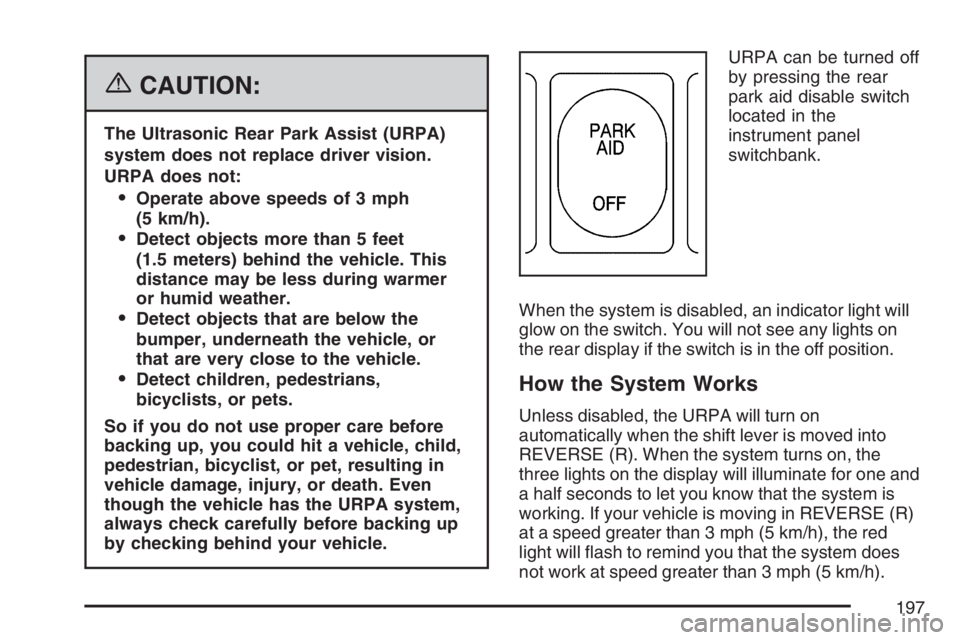
{CAUTION:
The Ultrasonic Rear Park Assist (URPA)
system does not replace driver vision.
URPA does not:
Operate above speeds of 3 mph
(5 km/h).
Detect objects more than 5 feet
(1.5 meters) behind the vehicle. This
distance may be less during warmer
or humid weather.
Detect objects that are below the
bumper, underneath the vehicle, or
that are very close to the vehicle.
Detect children, pedestrians,
bicyclists, or pets.
So if you do not use proper care before
backing up, you could hit a vehicle, child,
pedestrian, bicyclist, or pet, resulting in
vehicle damage, injury, or death. Even
though the vehicle has the URPA system,
always check carefully before backing up
by checking behind your vehicle.URPA can be turned off
by pressing the rear
park aid disable switch
located in the
instrument panel
switchbank.
When the system is disabled, an indicator light will
glow on the switch. You will not see any lights on
the rear display if the switch is in the off position.How the System Works
Unless disabled, the URPA will turn on
automatically when the shift lever is moved into
REVERSE (R). When the system turns on, the
three lights on the display will illuminate for one and
a half seconds to let you know that the system is
working. If your vehicle is moving in REVERSE (R)
at a speed greater than 3 mph (5 km/h), the red
light will �ash to remind you that the system does
not work at speed greater than 3 mph (5 km/h).
197
Page 198 of 528

If an object is detected at a REVERSE (R) speed
of less than 3 mph (5 km/h), one of the following
will occur:
Description English Metric
amber light 5 ft 1.5 m
amber/amber lights 40 in 1.0 m
amber/amber/red lights &
continuous chime20 in 0.5 m
amber/amber/red lights
�ashing & continuous
chime1 ft 0.3 m
A chime will sound the �rst time an object is
detected between 20 inches (0.5 m) and 5 feet
(1.5 m) away.
URPA cannot detect objects that are above liftgate
level. In order for the rear sensors to recognize
an object, it must be within detection range behind
the vehicle.
When the System Does Not Seem to
Work Properly
The light may �ash red when the vehicle is in
REVERSE (R) if the ultrasonic sensors are
not kept clean. So be sure to keep your rear
bumper free of mud, dirt, snow, ice, and slush.
Other conditions that may affect system
performance include things like the vibrations from
a jackhammer or the compression of air brakes
on a very large truck. If after cleaning the
rear bumper and then driving forward at least
15 mph (25 km/h), the display continues to �ash
red, see your dealer.
If a trailer was attached to your vehicle, or a
bicycle or an object was on the back of, or hanging
out of your liftgate during your last drive cycle,
the light may also �ash red. The light will continue
to �ash whenever in REVERSE (R) until your
vehicle is driven forward at least 15 mph (25 km/h)
without any obstructions behind the vehicle.
For cleaning instructions, seeWashing Your
Vehicle on page 455.
198
Page 206 of 528
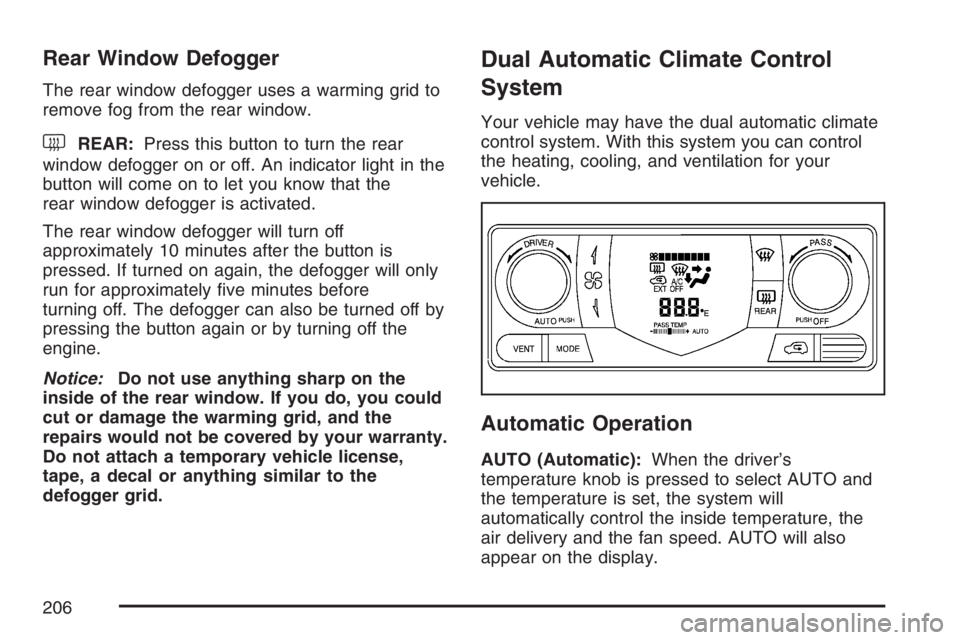
Rear Window Defogger
The rear window defogger uses a warming grid to
remove fog from the rear window.
button will come on to let you know that the
rear window defogger is activated.
The rear window defogger will turn off
approximately 10 minutes after the button is
pressed. If turned on again, the defogger will only
run for approximately �ve minutes before
turning off. The defogger can also be turned off by
pressing the button again or by turning off the
engine.
Notice:Do not use anything sharp on the
inside of the rear window. If you do, you could
cut or damage the warming grid, and the
repairs would not be covered by your warranty.
Do not attach a temporary vehicle license,
tape, a decal or anything similar to the
defogger grid.
Dual Automatic Climate Control
System
Your vehicle may have the dual automatic climate
control system. With this system you can control
the heating, cooling, and ventilation for your
vehicle.
Automatic Operation
AUTO (Automatic):When the driver’s
temperature knob is pressed to select AUTO and
the temperature is set, the system will
automatically control the inside temperature, the
air delivery and the fan speed. AUTO will also
appear on the display.
206
Page 207 of 528
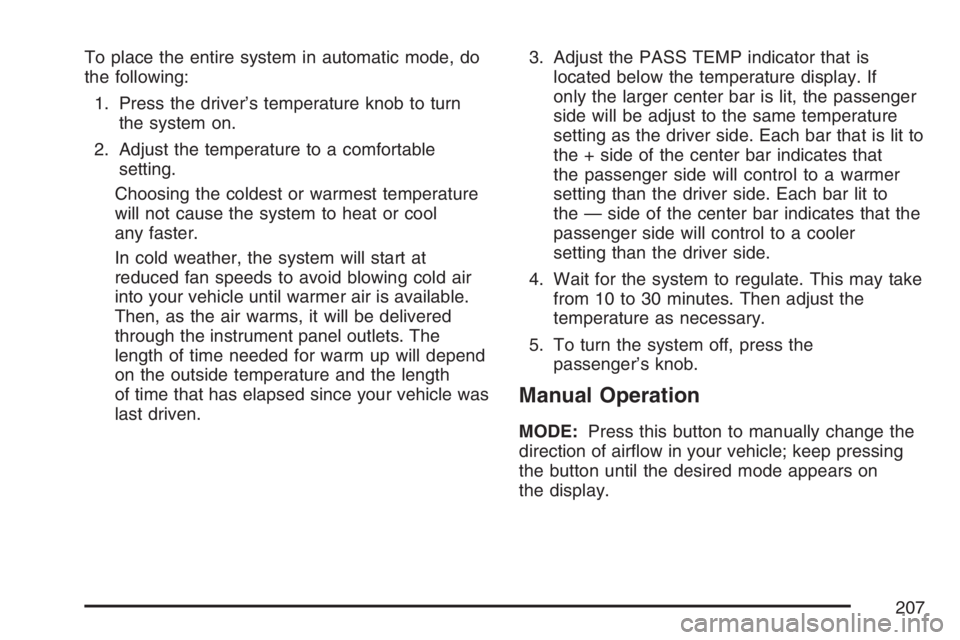
To place the entire system in automatic mode, do
the following:
1. Press the driver’s temperature knob to turn
the system on.
2. Adjust the temperature to a comfortable
setting.
Choosing the coldest or warmest temperature
will not cause the system to heat or cool
any faster.
In cold weather, the system will start at
reduced fan speeds to avoid blowing cold air
into your vehicle until warmer air is available.
Then, as the air warms, it will be delivered
through the instrument panel outlets. The
length of time needed for warm up will depend
on the outside temperature and the length
of time that has elapsed since your vehicle was
last driven.3. Adjust the PASS TEMP indicator that is
located below the temperature display. If
only the larger center bar is lit, the passenger
side will be adjust to the same temperature
setting as the driver side. Each bar that is lit to
the + side of the center bar indicates that
the passenger side will control to a warmer
setting than the driver side. Each bar lit to
the — side of the center bar indicates that the
passenger side will control to a cooler
setting than the driver side.
4. Wait for the system to regulate. This may take
from 10 to 30 minutes. Then adjust the
temperature as necessary.
5. To turn the system off, press the
passenger’s knob.
Manual Operation
MODE:Press this button to manually change the
direction of air�ow in your vehicle; keep pressing
the button until the desired mode appears on
the display.
207
Page 208 of 528
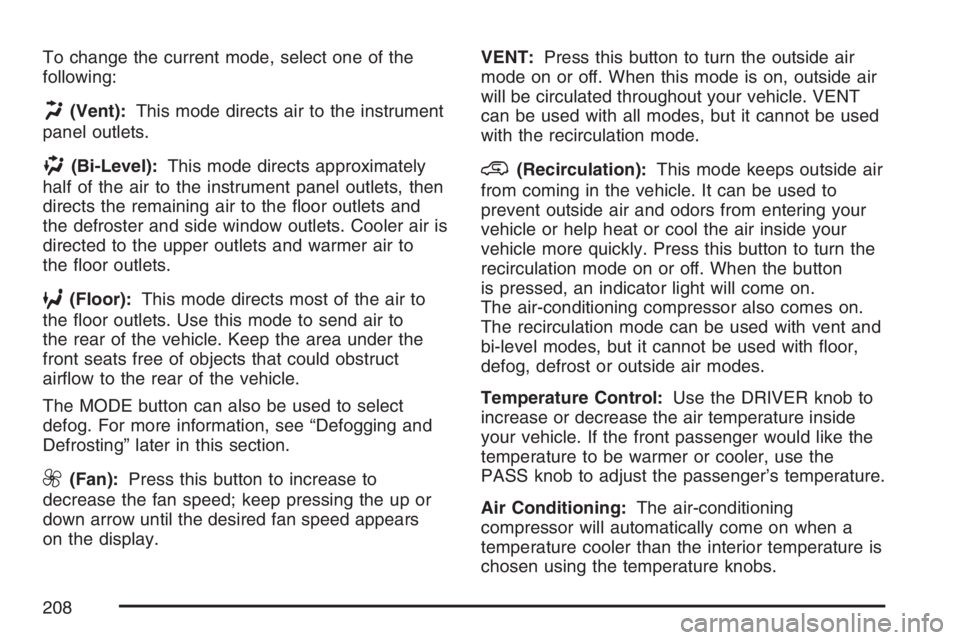
To change the current mode, select one of the
following:
H(Vent):This mode directs air to the instrument
panel outlets.
)(Bi-Level):This mode directs approximately
half of the air to the instrument panel outlets, then
directs the remaining air to the �oor outlets and
the defroster and side window outlets. Cooler air is
directed to the upper outlets and warmer air to
the �oor outlets.
6(Floor):This mode directs most of the air to
the �oor outlets. Use this mode to send air to
the rear of the vehicle. Keep the area under the
front seats free of objects that could obstruct
air�ow to the rear of the vehicle.
The MODE button can also be used to select
defog. For more information, see “Defogging and
Defrosting” later in this section.
9(Fan):Press this button to increase to
decrease the fan speed; keep pressing the up or
down arrow until the desired fan speed appears
on the display.VENT:Press this button to turn the outside air
mode on or off. When this mode is on, outside air
will be circulated throughout your vehicle. VENT
can be used with all modes, but it cannot be used
with the recirculation mode.
@(Recirculation):This mode keeps outside air
from coming in the vehicle. It can be used to
prevent outside air and odors from entering your
vehicle or help heat or cool the air inside your
vehicle more quickly. Press this button to turn the
recirculation mode on or off. When the button
is pressed, an indicator light will come on.
The air-conditioning compressor also comes on.
The recirculation mode can be used with vent and
bi-level modes, but it cannot be used with �oor,
defog, defrost or outside air modes.
Temperature Control:Use the DRIVER knob to
increase or decrease the air temperature inside
your vehicle. If the front passenger would like the
temperature to be warmer or cooler, use the
PASS knob to adjust the passenger’s temperature.
Air Conditioning:The air-conditioning
compressor will automatically come on when a
temperature cooler than the interior temperature is
chosen using the temperature knobs.
208
Page 213 of 528
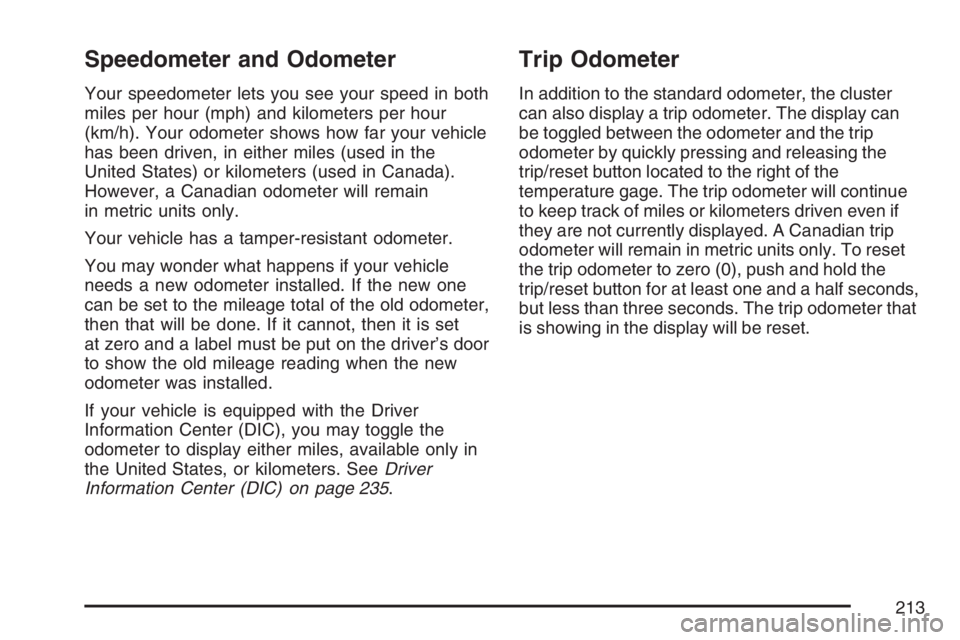
Speedometer and Odometer
Your speedometer lets you see your speed in both
miles per hour (mph) and kilometers per hour
(km/h). Your odometer shows how far your vehicle
has been driven, in either miles (used in the
United States) or kilometers (used in Canada).
However, a Canadian odometer will remain
in metric units only.
Your vehicle has a tamper-resistant odometer.
You may wonder what happens if your vehicle
needs a new odometer installed. If the new one
can be set to the mileage total of the old odometer,
then that will be done. If it cannot, then it is set
at zero and a label must be put on the driver’s door
to show the old mileage reading when the new
odometer was installed.
If your vehicle is equipped with the Driver
Information Center (DIC), you may toggle the
odometer to display either miles, available only in
the United States, or kilometers. SeeDriver
Information Center (DIC) on page 235.
Trip Odometer
In addition to the standard odometer, the cluster
can also display a trip odometer. The display can
be toggled between the odometer and the trip
odometer by quickly pressing and releasing the
trip/reset button located to the right of the
temperature gage. The trip odometer will continue
to keep track of miles or kilometers driven even if
they are not currently displayed. A Canadian trip
odometer will remain in metric units only. To reset
the trip odometer to zero (0), push and hold the
trip/reset button for at least one and a half seconds,
but less than three seconds. The trip odometer that
is showing in the display will be reset.
213
Page 214 of 528

Retro-Active Reset
The trip odometer has a feature called retro-active
reset. This feature can be used to set the trip
odometer to the number of miles or kilometers
driven since the ignition was last turned on. This
can be used if you forget to reset your trip odometer
at the beginning of a trip. To use the retro-active
reset feature, push and hold the trip/reset button for
at least �ve seconds. The trip odometer will then
display the number of miles or kilometers driven
since the ignition was last turned on and you began
driving. If you use the retro-active reset feature after
you have started the vehicle, but before you begin
moving, the display will show the number of miles
or kilometers you drove during the last ignition
cycle. Once you begin driving, the trip odometer will
accumulate mileage. For example, if you have
driven 5.0 miles (8.0 km) since you started your
vehicle, and then activate the retro-active reset
feature, the display will show 5.0 miles (8.0 km). As
you drive, the display will then increase to 5.1 miles
(8.2 km), 5.2 miles (8.4 km), etc.
Tachometer
The tachometer displays
the engine speed in
revolutions per
minute (rpm).
214
Page 226 of 528

Passenger Seatbelt Reminder
Message
If your vehicle has the
passenger sensing
system, this message
reminds the passenger
to buckle their
seatbelt.
This message will come on and a chime will
sound when the following conditions exist:
The ignition is ON,
the passenger’s seatbelt is not buckled,
a passenger is detected by the passenger
sensing system.
This light and chime will be repeated if the
ignition is on, the vehicle is in motion,
the passenger is still unbuckled and the
passenger airbag is enabled. You should
buckle your seatbelt. If the passenger’s
seatbelt is already buckled, this message and
chime will not come on.
Service Traction System Warning
Message
If your vehicle has the Traction Control System
(TCS) and this message is displayed when you are
driving, there may be a problem with your TCS.
Your vehicle may need service.
When this message is displayed, the TCS will not
limit wheel spin. Adjust your driving accordingly.
If there is an engine-related and brake system
problem that is speci�cally related to traction
control, the TCS will turn off and the warning
message will come on.
If the TCS warning message comes on and stays
on for an extended period of time when the
system is turned on, your vehicle needs service.
United StatesCanada
226
Page 235 of 528
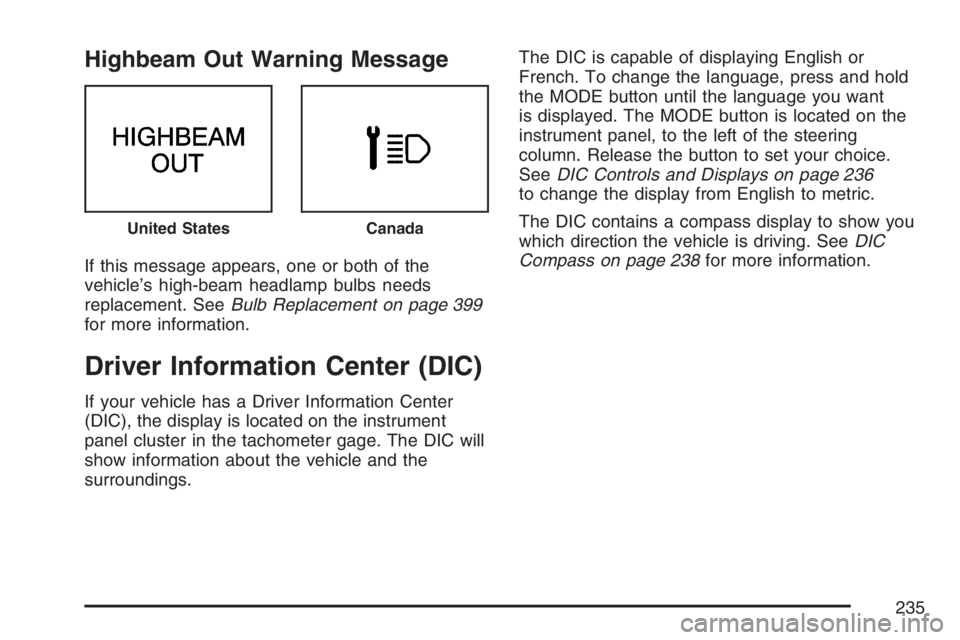
Highbeam Out Warning Message
If this message appears, one or both of the
vehicle’s high-beam headlamp bulbs needs
replacement. SeeBulb Replacement on page 399
for more information.
Driver Information Center (DIC)
If your vehicle has a Driver Information Center
(DIC), the display is located on the instrument
panel cluster in the tachometer gage. The DIC will
show information about the vehicle and the
surroundings.The DIC is capable of displaying English or
French. To change the language, press and hold
the MODE button until the language you want
is displayed. The MODE button is located on the
instrument panel, to the left of the steering
column. Release the button to set your choice.
SeeDIC Controls and Displays on page 236
to change the display from English to metric.
The DIC contains a compass display to show you
which direction the vehicle is driving. SeeDIC
Compass on page 238for more information.
United StatesCanada
235
Page 236 of 528

DIC Controls and Displays
When the ignition is turned to ON or START, the
DIC will display the following:
BUICK:BUICK will be displayed for three
seconds.
DRIVER #:This message will be displayed for
another three seconds after BUICK appears in the
display. The driver number corresponds to the
numbers, 1 or 2, on the back of the Remote
Keyless Entry (RKE) transmitters. This display lets
the driver know which driver’s RKE transmitter
is being used and the driver’s customization
features.
The DIC controls are
located to the left of the
steering column on
the instrument panel.The DIC will be in the last mode displayed when
the engine was turned off. To select a different
mode, press MODE. The display will cycle through
its options at each press of MODE.
MODE:This button lets you cycle through the
options on the display.
SET:This button is used to select and set the
options to your preference.
The DIC will always display the compass reading
and the outside temperature. If the temperature
is below 38°F (3°C), the temperature reading will
toggle between displaying the temperature and
the word ICE for two minutes.
AVG ECONOMY (Average Economy):Average
fuel economy is viewed as a long term
approximation of your overall driving conditions.
To learn the average fuel economy from a
new starting point, press and hold the SET button
while the average fuel economy is displayed on
the DIC. The average fuel economy will set
to zero.
236